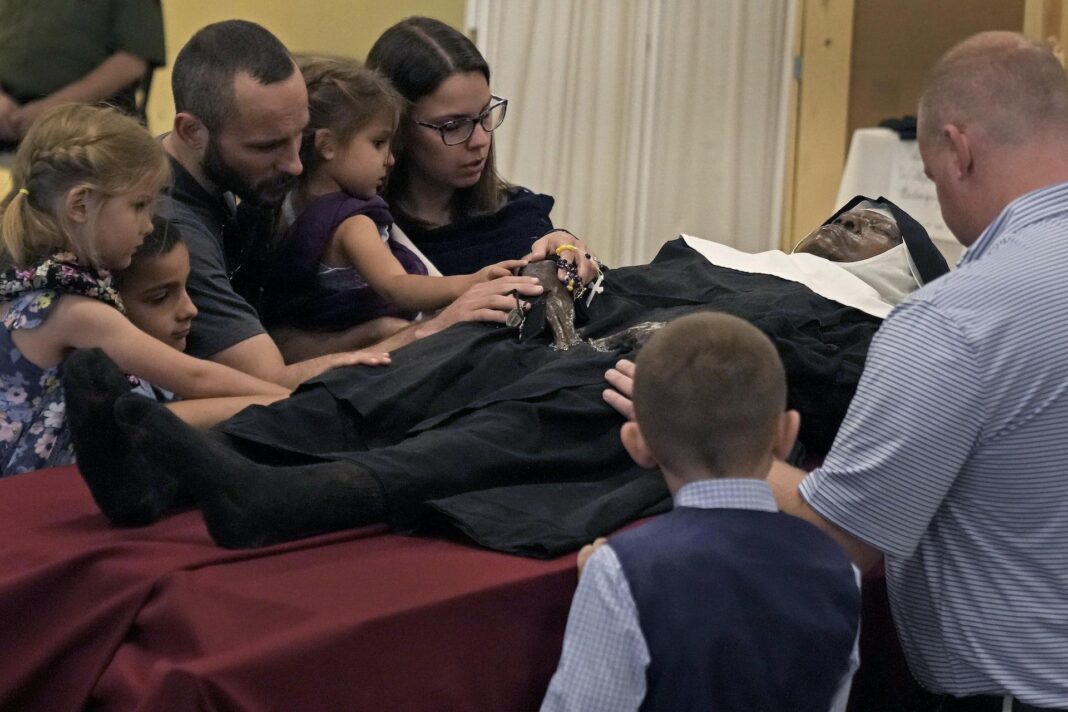Catholic tradition offers occasional examples of holy men and women whose bodies, exhumed some years after death, remained completely or partially untouched by the natural process of decay.
Sometimes witnesses have also reported the scent of flowers instead of the odor of decay from the open coffin; others have described seeing a bright light illuminating the grave itself.
These are examples of a rare phenomenon referred to as incorruptibility.
Clergy and laypeople sometimes argue these are special signs from God that the person should be venerated as a saint. Officially, however, incorruptibility is no longer considered a miracle, a requirement for proclaiming someone a saint.
As a specialist in Catholic liturgy and ritual, I know that these occurrences have a long and complicated history.
Techniques for anointing and embalming the bodies of the dead were well known in the ancient Near East and were used occasionally in Greek and Roman antiquity. However, in early medieval Europe, these techniques were rarely used until they were rediscovered in the later Middle Ages and practiced well into the Renaissance.
As medical knowledge expanded, these procedures became more sophisticated. Since the 18th century, church officials seriously considered other factors that could have rendered a body more immune from decay, like attempts at embalming or burial conditions supporting natural mummification.
Nonetheless, for many Catholics, incorruptibility was a sign of sanctity. There were also instances of partial incorruptibility, when only a part of the body would remain untouched by decay. These would also be preserved in a church or shrine and venerated by pilgrims.
Thousands of Catholics turned up to view the right arm of the 16th-century Jesuit missionary St. Francis Xavier, which was taken on a pilgrimage tour of Canada in 2017 and 2018. This saint, who became famous for baptizing thousands of people in Asia, was buried on an island off China upon his death. His body, considered incorrupt, was later returned to Goa in India, where the right arm was cut off and sent to the Jesuits in Rome. Over time, other parts of the body were also removed for veneration in other locations.
Today, the incorrupt body of a saint is no longer considered a miracle in support of a canonization, although a report can still prompt Catholics to travel to venerate it. In April 2023, for example, thousands of pilgrims traveled to Missouri to view the body of the founder of the Benedictine sisters of Gower, an independent monastic community of women following precepts set by sixth-century Italian monk St. Benedict of Nursia. Sister Wilhelmina Lancaster died in 2019, but her body and religious clothing were found to be virtually intact when her coffin was opened in 2023.
Contemporary Catholic teaching situates the phenomenon of incorruptibility in the context of Christ’s resurrection from the dead and ascension into heaven.
Elsewhere in the New Testament, St. Paul stresses this, and, like most Christian churches, the Catholic Church emphasizes that the resurrection of the faithful from the dead at the end of time will be like “Christ’s own resurrection.” The incorrupt bodies of some saints are understood to be a sign of that promise.
Usually, the incorrupt body is taken to a nearby church soon after its discovery and displayed to the faithful, often in a glass tomb. Since these remains frequently decay naturally after exhumation, the face and other parts may be covered with wax or silicone.
Catholics have always viewed saints as intercessors and partners in prayer, whether in gathering by their graves or venerating their relics, which could include pieces of bone, hair, ashes or clothing they have left behind. Even today, pilgrims travel miles to pray by the remains of these “incorruptibles.”
This is understood to be an exceptional expression of what Pope Francis has called the “mysterious solidarity in Christ” between the living and the dead in expectation of eternal life to come.
This article is republished from The Conversation, an independent nonprofit news site dedicated to sharing ideas from academic experts. The Conversation has a variety of fascinating free newsletters.
Read more: No justice, no peace: Why Catholic priests are kneeling with George Floyd protesters I went on a Voodoo pilgrimage in Haiti
Joanne M. Pierce does not work for, consult, own shares in or receive funding from any company or organization that would benefit from this article, and has disclosed no relevant affiliations beyond their academic appointment.








